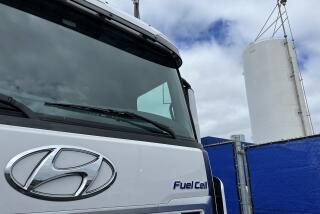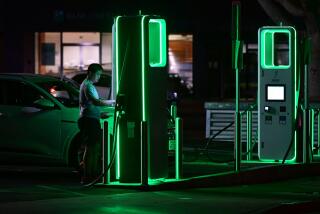Hybrid sports car on the drawing board
A sleek and powerful hybrid sports car concept that Honda Motor Co. unveiled last year at the Tokyo Auto Show could be the basis of a real production car from Acura.
If given the go-ahead, the car--code-named the DN-X--would turn heads not only because of its looks but also because it would show that hybrids don’t have to be automotive milquetoasts.
The concept car used a 300-horsepower V-6 coupled with a 100-horsepower electric motor to give it the performance of a 400-horsepower muscle car with excellent fuel economy.
It’s not quite what the Sierra Club had in mind when it awarded Honda its first endorsement of an automotive product at the introduction of the Insight hybrid in Los Angeles a few years ago. But Honda officials say making hybrid power systems available across a broad spectrum of product types -- including performance cars -- is the best way to win widespread consumer acceptance.
A high-output gas engine, even in a Honda, is not going to be emission-free, but it could garner a low-emission vehicle or even a super-ultra-low-emission vehicle rating, depending on how it is tuned. And when augmented with a high-torque electric motor that will provide lots of boost during acceleration, the system shown on the DN-X could achieve average fuel economy of 42 miles per gallon.
Not bad considering most 400-horsepower cars and trucks are doing well these days if they hit 15 mpg.
The concept, which was called the Honda Dualnote when it was shown at Tokyo and became the Acura DN-X this year at the New York Auto Show, uses the gasoline engine to drive the rear wheels and the electric motor to drive all four wheels. Honda has used the same system -- with a smaller gas engine -- in a concept sport utility vehicle, the RDX hybrid, shown this year at the North American International Auto Show in Detroit.
Acura spokesman Mike Spencer, at American Honda Motor Co. in Torrance, says there’s been no decision on a production version of either concept, but repeats what top Honda officials have said several times in the last two years: The company wants to go beyond its present hybrid offerings, the two-seat Insight and the five-seat Civic Hybrid, with gas-electric powertrain technology.
“It could be an all-wheel-drive system” suitable for a hybrid SUV derived from the RDX concept “or an all-wheel-drive, high-performance system” such as that shown on the Dualnote/DN-X “or both,” he said, leaving open the likelihood that both an SUV and a sports car are on the table but offering little clue as to which might be first.
Detroit-based AutoWeek magazine recently reported that it will be the sports car, and no less an authority than Tom Elliot, American Honda’s executive vice president, also has said that a hybrid Acura sports car is the likely follow-up to the Honda Insight and Civic hybrids.
Justification for a hybrid high-performance Acura, other than helping spread the word about dual-power systems, is that it enables the car maker to boost performance without installing “a gas-guzzling V-10 or V-12,” as some of the competitors are doing, Spencer said.
Using the smaller V-6 and integrated electric motor also gives Honda designers lots of room for a large passenger cabin in a compact exterior package.
Natural gas stations
Efforts to market natural gas-powered vehicles have long been frustrated by a dearth of public refueling stations.
Now Toronto-based FuelMaker Corp. has developed and will begin selling a home fueling system that hooks into residential gas lines and makes it possible to fill a natural gas vehicle’s tanks daily.
Pricing for the device, called Phill, hasn’t been set, but FuelMaker says it hopes to bring it to market for less than $2,000 next year. The price should fall to $999 when volume production is achieved. That should be within two years of introduction, said FuelMaker spokeswoman Amy Chaput, but it depends on public acceptance of natural gas vehicles.
Concurrently, and not coincidentally, American Honda says it will start marketing its natural gas vehicle, the Honda Civic GX, to retail customers in all 50 states by next spring. American Honda owns 20% of FuelMaker.
The Civic GX has been around since 1998, but like other natural gas vehicles from Ford Motor Co., General Motors Corp. and Chrysler Corp., it is sold almost exclusively for government fleets, because Honda did not believe the public would be comfortable with a car with hard-to-find fuel.
“Home refueling will help to increase consumer acceptance of natural gas-powered vehicles,” said Robert Bienenfeld, senior manager of product planning at American Honda and chairman of the Natural Gas Vehicle Coalition board of directors. “Our research indicates people like the idea of being able to refuel their vehicles at home.”
FuelMaker says Phill can be installed in a garage and allows natural gas-powered vehicles to be refueled from a homeowner’s existing natural gas supply line.
The system compresses gas from the residential line and pumps it into the vehicle’s tank through a special nozzle.
It will be certified as a natural gas appliance, meeting the same safety requirements as natural gas water heaters and clothes dryers, and come with a gas leak warning alarm that automatically shuts down the system in the event of a leak, Chaput said.
The Civic GX sedan uses a 1.7-liter four-cylinder engine with a range of up to 220 miles on an eight-gallon tank of compressed natural gas. Base price is $20,510, and Honda figures it will sell about 5,000 a year.
Honda describes the GX as a “nearly zero-emissions” car, and the California Air Resources Board certifies it as a super-ultra-low-emission vehicle. (It also qualified for the board’s special PZEV, or partial zero-emission-vehicle, credit when the state’s zero-emission-vehicle mandate was in force, but that has been put aside until a General Motors suit challenging the ZEV mandate is resolved.)
One immediate boost for natural gas vehicle sales in California might be that state law lets them use freeway diamond lanes as single-occupant vehicles, the same benefit allowed motorcycles and electric vehicles (hybrids, which combine gasoline engines and electric motors, cannot use the diamond lanes unless there are two or more people inside).
In addition to the Civic GX, another natural gas vehicle now available is the Ford Crown Victoria, said Paul Vetter, spokesman for the California Natural Gas Vehicle Coalition. Consumers, however, will face the task of persuading a dealer to order one.
Chevrolet makes a natural gas Cavalier sedan; Ford and General Motors make natural gas pickup trucks; and Ford, GM and Chrysler make natural gas vans, but those vehicles are marketed almost exclusively as commercial and government fleet vehicles, Vetter said.
*
John O’Dell writes about the auto industry for Highway 1 and The Times’ business section. He can be reached at john.odell@latimes.com.






